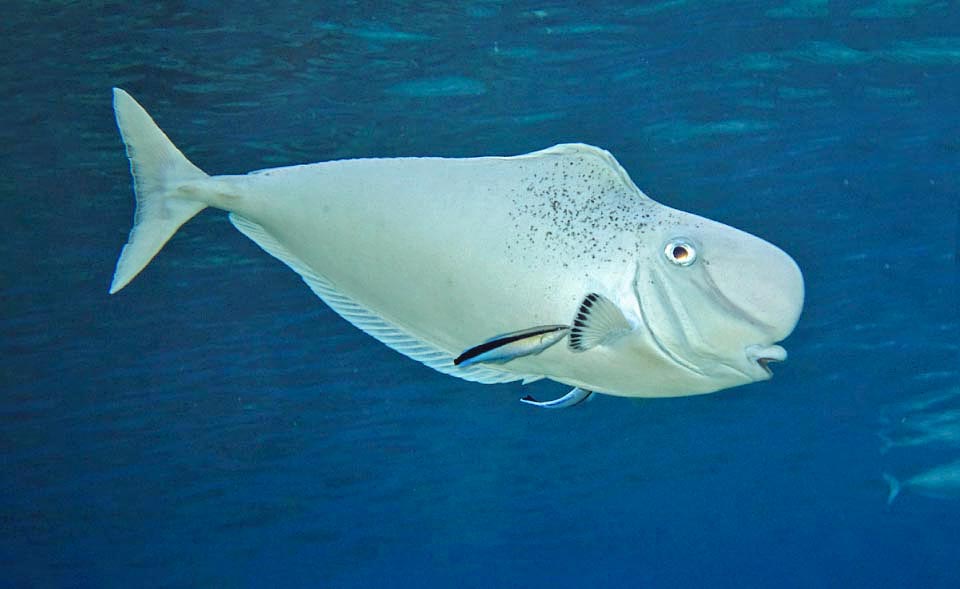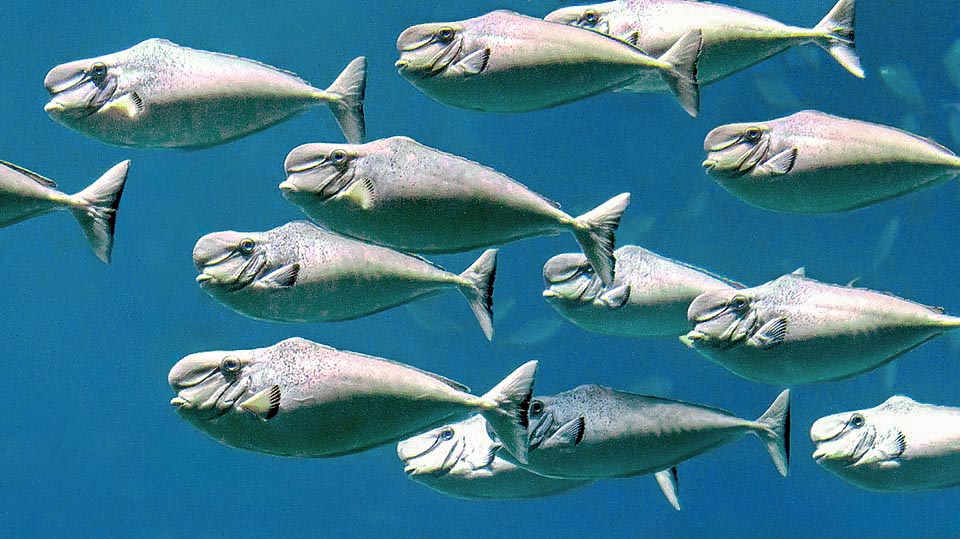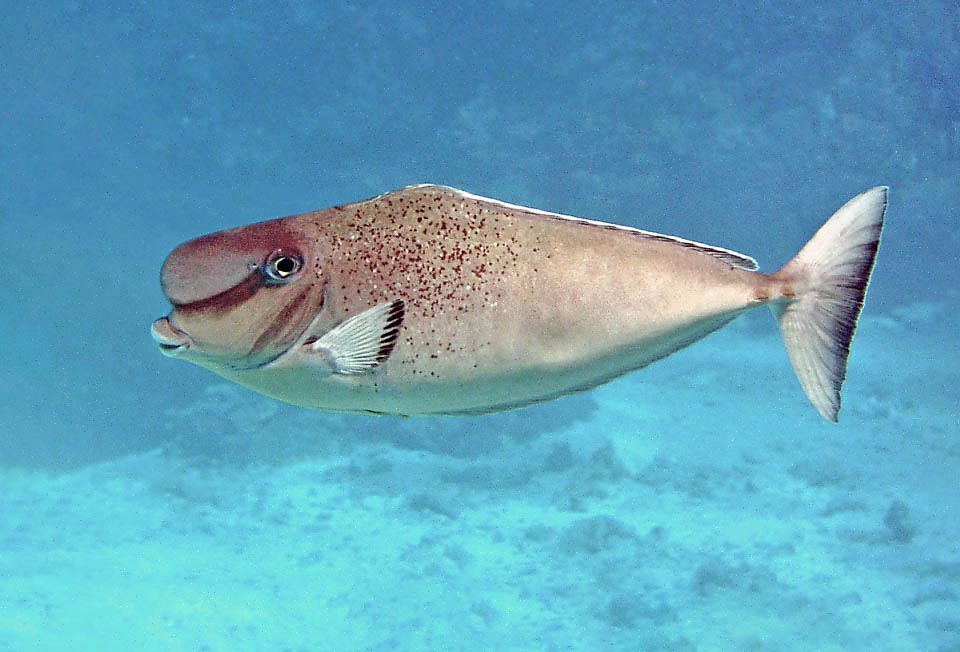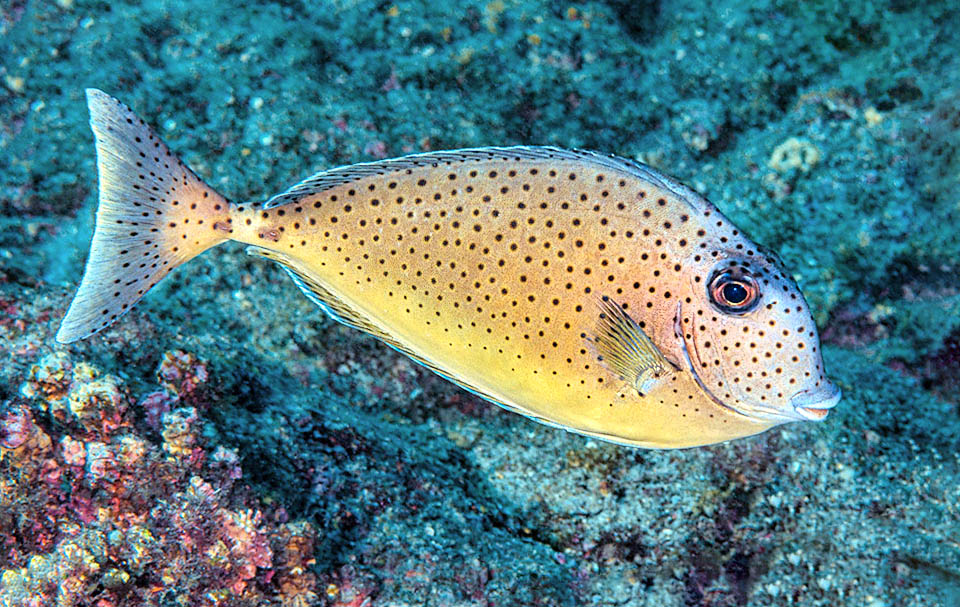Family : Acanthuridae

Text © Giuseppe Mazza

English translation by Mario Beltramini

Even if it gets the name from Tonga Island, Naso tonganus is present in most of tropical Indo-Pacific © Lyle Vail
Naso tonganus (Valenciennes, 1835) belongs to the class of the Actinopterygii, the ray-finned fishes, to the order of the Perciformes, to the family of the Acanthuridae and to the subfamily of the Nasinae, regrouping about twenty species all assigned to the genus Naso, from the Latin “nasus” = nose, due to the showy bony protuberance, like a nose or a horn, hence the vulgar name assigned to all Unicorn fishes.
The specific term tonganus, in Latin “of Tonga”, refers to Tonga Island, in the southern Pacific, where this fish is present.
Zoogeography
The range of the species is much vaster, with distribution covering most of tropical Indo-Pacific.
Indicatively, we find it in Tanzania and in South Africa. It is present in the waters of Madagascar and in the adjacent islands, Comoros, Réunion, Seychelles, Chagos and Maldives, in India and in Sri Lanka, then in Christmas Island, Malaysia, Indonesia and further north along the Philippines coasts, Taiwan and Japan, even if here the sightings are rare and usually concern stray specimens, that have followed the schools of other Acanthuridae.

In schools at times, it’s a pacific herbivore that can reach the 60 cm of length, grazing any sort of algae © Giuseppe Mazza
In Oceania, after Australia and Papua New Guinea, it reaches New Caledonia. Going eastwards, it has colonized Micronesia and, of course, Tonga. Finally, we find it also in Samoa and the Cook Islands, which mark the eastern limit of the species.
Ecology-Habitat
It is a diurnal herbivorous benthopelagic fish, associated with the corals formations, swimming usually between 2 and 40 m of depth. It cleans up the madrepores from the infesting filamentous algae and spends most of the day grazing the most consistent ones, green or red, growing on the rocks. It finds them abundantly in the sunny lagoons and the estuaries, but often grazes in small schools also on the outer side of the reefs.
Morphophysiology
Naso tonganus can reach the length of 60 cm. The profile of the body is oval and the great bony bump over the fleshy lips is much more pronounced than in Naso vlamingii. Then, there is a second showy hump on the back just after the head. The caudal peduncle is narrow with two hooked blades per side. Bigger in the males, they are the only evident sexual dimorphism.

Showy bumps near the eyes and on the back. It differs from Naso tuberosus because of the small spots present only around the hump and the black margin of the pectorals © Reef EcoImages, Andy Lewis
There is only one long dorsal fin counting 5 spiny rays and 27-30 soft. The anal is symmetrical with 2 spiny rays and 26-28 unarmed. The pectoral ones have 16-18 soft rays, and the pelvic, pointed, have one spiny ray and three unarmed. The caudal fin is truncate, slightly concave without the long and spectacular lateral filaments present in some congeners, such as Naso elegans or Naso vlamingii.
The background colour of the body, that remarkably weakens on the side in the lower half of the fish, is silver grey, tending to yellowish on the abdomen. The zone around the hump presents a fine black dotting and the head has two oblique dark bands. The first, that for far may give the idea of a huge mouth, goes from the upper lip to the eye, whilst the other is parallel to the branchial opening.
Also the pectoral fins and the caudal one have a black band. The dorsal is dark, usually edged in a more showy blue colour than the caudal and the anal. This is the only note of colour in a species having no chromatic ambitions, where also the defensive blades on the caudal fin, of flaming red colour in Naso elegans and turquoise blue in Naso unicornis, are simply black.
Naso tonganus is at times mistaken with Naso tuberosus.It also displays two humps and is at first sight quite similar. It distinguishes for the nasal protuberance, shorter, that hardly reaches the profile of the upper lip, and for the tiny black spots on the back, that are bigger, present on the whole upper part of the fish and the whole caudal fin. Moreover, is absent the typical black stripe of Naso tonganus at the edge of the pectoral fins,replaced by a dark spot on the chest between these and the operculum.

The juveniles do not have the characteristic bony protuberance of the adults and are protected by a dense black camouflage marking © François Libert
Ethology-Reproductive Biology
Naso tonganus usually lives solitary or small groups. The mating, however, is not collective, but is a mere matter of couples. The eggs, fecundated while swimming, are entrusted to the currents. The larval stage lasts a long time and the young in this way often colonize far away sites. They have a roundish profile and are protected all over the body by a dense mimetic black spotting.
The resilience of the species is mediocre, seen that it takes 1.4-4.4 years to rebuild populations decimated by events, and the index of vulnerability to fishing, relatively high, marks 49 on a scale of 100.
The populations are stable, however, and since 2010 Naso tonganus has been listed as “LC, Least Concern” in the IUCN Red List of endangered species.
Synonyms
Naseus tonganus Valenciennes, 1835.
→ For general information about FISH please click here.
→ For general information about BONY FISH please click here
→ For general information about CARTILAGINOUS FISH please click here.
→ To appreciate the BIODIVERSITY of BONY FISH please click here.
→ To appreciate the BIODIVERSITY of CARTILAGINOUS FISH please click here.
